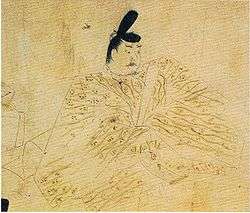Fujiwara no Yorinaga

Fujiwara no Yorinaga (藤原 頼長, May 1120 – August 1, 1156), of the Fujiwara clan, held the position of Imperial Palace Minister of the Right.[1]
Born in 1120, Yorinaga ascended quickly through the political ranks achieving a formidable office of Naidaijin by the age of 17. In 1150, he was appointed Minister of the Left, the highest rank under the Regent. He married his daughter to Emperor Konoe. Yorinaga was one of the last major advocates of restoring the once powerful Fujiwara Regency, which was the ruling political faction in Japan from about 794-967. In addition to his political aspirations, Yorinaga was a scholar of sorts who kept detailed memoirs that described his studies in Indian logic and other foreign studies.[2]
Political career
Yorinaga was a dogmatic activist who displayed a great deal of courage in his actions. Consequently, he made many enemies who resented his disapproval of the current Emperor Konoe and his cloistered puppet master Toba. In 1155, Konoe died and a succession dispute arose for the imperial throne. After much quarrel, the former emperor Toba’s son became Emperor Go-Shirakawa. This was the worst result in Yorinaga’s view. On top of this, Yorinaga was refused the position of “tutor to the Heir Apparent” despite his qualifications.[2]
Hogen Insurrection
After being insulted by the Go-Shirakawa Party, Yorinaga joined with Sutoku, one of Toba’s other sons. They collected troops from outer provinces with the goal of marching on the capital. Yorinaga was only able to gather a few hundred soldiers while Go-Shirikawa had the backing of both the Minamoto and Taira warrior clans. The Hogen Insurrection symbolized the beginning of a major political evolution by which Japan would evolve to a feudal state. The actual conflict took place after nightfall when Sutoku and Yorinaga’s defensive position was attacked and destroyed. Yorinaga was killed and his chief comrades surrendered. However, some fifty of Emperor Sutoku's supported were put to death.[2]
Yorinaga’s Lost Cause
Within Japanese history, Yorinaga is remembered for his courage and determination for what most recall as a lost cause. Since his struggle was a political failure, history rarely pays detailed attention to his part in the bigger political evolution that was taking place in the mid-12th century. Instead of restoring the aristocracy, he became the last champion.[2]
His death symbolized the beginning of the growth of the warrior class and a war-like state that would exist within Japan until the unification under Tokugawa Ieyasu around 1600.
